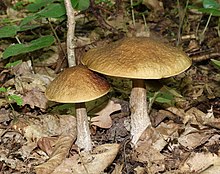
Amanita porphyria, also known as the grey veiled amanita or the porphyry amanita, is a fairly common, inedible mushroom of the genus Amanita found in Europe and North America.
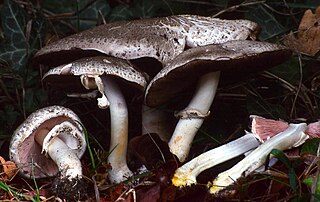
Agaricus moelleri, commonly known as the flat-top agaricus, inky mushroom, or dark scaled mushroom, is a large mushroom of the genus Agaricus. It appears occasionally in most kinds of woodland, during late summer, in northern temperate zones.

Leratiomyces ceres, commonly known as the Redlead Roundhead, is mushroom which has a bright red to orange cap and dark purple-brown spore deposit. It is usually found growing gregariously on wood chips and is one of the most common and most distinctive mushrooms found in that habitat. It is common on wood chips and lawns in North America, Europe, Australia, New Zealand and elsewhere. The name Stropharia aurantiaca has been used extensively but incorrectly for this mushroom.
Panaeolus africanus is a little brown mushroom that contains irregular amounts of the hallucinogens psilocybin and psilocin. It has been found in central Africa and southern Sudan.
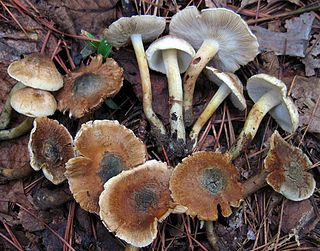
Inocybe corydalina var. corydalina, commonly known as the greenflush fibrecap, is a member of the genus Inocybe which is widely distributed in temperate forests. It is a small mycorrhizal mushroom which contains a small amount of the hallucinogen psilocybin.

Russula nigricans, commonly known as the blackening brittlegill or blackening russula, is a gilled mushroom found in woodland in Europe. It gains both its common and scientific name from its propensity to turn black from cutting or bruising.

Amanita excelsa var. spissa is a variety of basidiomycete fungus of the genus Amanita. This large, grey to brown-capped fungus has a very variable appearance but is commonly encountered in coniferous and deciduous forests in Europe and North America. It is sometimes referred to by the common name grey spotted Amanita.
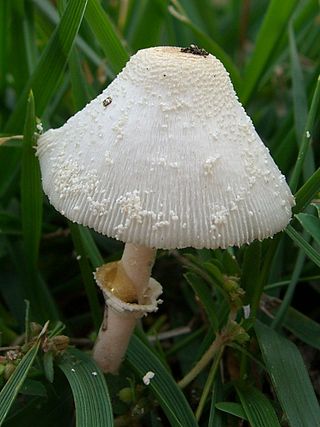
Leucocoprinus cepistipes, is a species of fungus in the family Agaricaceae. It is typically found on wood debris, such as wood chips but may also grow in potted plants or greenhouses. Typical characteristics include a fine-scaled bell-shaped cap, a partial veil, and a tendency to bruise a yellow to brown when handled.

Conocybe rickenii is a mushroom from the genus Conocybe. Its edibility is disputed, and it has the appearance of a typical little brown mushroom with a small, conical cap, and long, thin stem. In colour, it is generally a cream-brown, lighter on the stem, and it has a thin layer of flesh with no distinct smell or taste. It is a coprophilous fungus, feeding off dung and it is most common on very rich soil or growing directly from dung. It can be found in Europe, Australia and Pacific islands.

Amanita nothofagi is a species of fungus in the family Amanitaceae. Endemic to New Zealand, the species was first described by mycologist Greta Stevenson in 1962. The fruit bodies have dark brown caps that are up to 13 cm (5.1 in) in diameter and covered with patches of soft greyish-brown scales or warts. The gills underneath the cap are crowded together, free from attachment to the stem, and white, becoming tinged with yellow in age. The stem of the mushroom is 4–14 cm (1.6–5.5 in) long by 0.5–2.5 cm (0.2–1.0 in) thick, and has a ring. The spore print is white, and individual spores are spherical to ellipsoid, measuring 7.5–9 by 7.5–9 micrometres. The mushroom may be confused with another New Zealand species, A. australis, but can be distinguished by certain characteristics. Amanita nothofagi is a mycorrhizal species, and grows in association with native New Zealand trees such as Southern Beech.

Agaricus silvaticus, otherwise known as the scaly wood mushroom, blushing wood mushroom, or pinewood mushroom, is a species of mushroom often found in groups in coniferous forests from early summer, or September through to November in Europe, North Africa and North America.

Cortinarius traganus, also known as the gassy webcap or lilac conifer cortinarius, is a basidiomycete mushroom of the genus Cortinarius. The mushrooms are characterized by their lilac color, the rusty-brown gills and spores, and rusty-brown flesh in the stem.
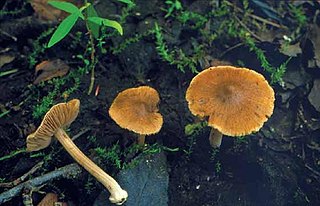
Inocybe saliceticola is a fungus found in moist habitats in the Nordic countries. The species produces brown mushrooms with caps of varying shapes up to 40 millimetres (1.6 in) across, and tall, thin stems up to 62 mm (2.4 in) long. At the base of the stem is a large and well-defined "bulb". The species produces unusually shaped, irregular spores, each with a few thick protrusions. This feature helps differentiate it from other species that would otherwise be similar in appearance and habit.

Pulveroboletus ravenelii, commonly known as Ravenel's bolete or the powdery sulfur bolete, is a species of bolete fungus in the family Boletaceae. Described as new to science in 1853, the widely distributed species is known from Asia, Australia, North America, Central America, and South America. Mycorrhizal with oak, the fungus fruits on the ground singly, scattered, or in groups in woods. Fruit bodies (mushrooms) have convex to flat, yellowish to brownish-red caps up to 10 cm (4 in) in diameter. On the cap underside, the pore surface is bright yellow before turning dingy yellow to grayish brown with age; it stains greenish blue then grayish brown after injury. A cottony and powdery partial veil remains as a ring on the stipe. The mushrooms are edible, and have been used in traditional Chinese medicine and for mushroom dyeing.

Ramaria fennica, commonly known as the bitter coral, is a coral mushroom in the family Gomphaceae. It is found in Australia, Europe and North America.

Russula alnetorum is a species of mushroom in the genus Russula. The fruiting bodies are found growing on the ground in the vicinity of alder trees with which this fungus has a symbiotic relationship. The cap is purple and the gills and stem white, darkening with age.
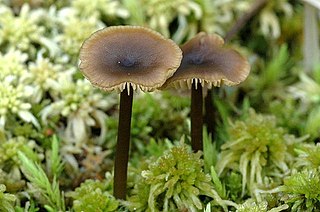
Sphagnurus paluster is a species of fungus in the family Lyophyllaceae which parasitizes Sphagnum moss. It was first described by Charles Horton Peck in 1872. It is commonly called the sphagnum greyling due to it being found in peat bogs and to its cap turning grey as it ages and dries.

Hemileccinum impolitum is a basidiomycete fungus of the family Boletaceae, native to Europe. It is commonly referred to as the iodine bolete, because its fruit bodies tend to emit an iodine odour when cut, more detectable in the stem base or overripe specimens.

Amanita longipes is a small inedible mushroom species of the Amanita genus. It feeds on decaying leaves of some woods and can be found around the Appalachian Mountains. It is a food source for various insects.
Leucocoprinus acutoumbonatus is a species of mushroom producing fungus in the family Agaricaceae.
